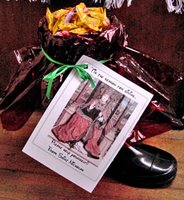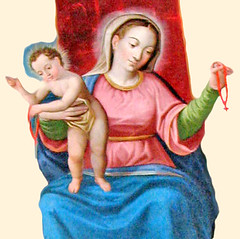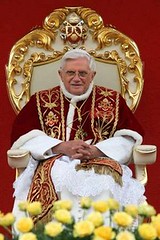Good St Nick!
 On December 6 we reach what is traditionally the most distinctive children's festival of the whole year, St Nicholas' day. It is not easy to get at the historic facts of about St Nicholas, the 4th century bishop of Myra in Asia Minor. The first account of his life was written by St Methodius in the 9th century. His relics in Myra were stolen by Italian merchants in 1087 and now rest at Bari in a shrine-church. Nevertheless he is universally popular and his legends have endured. He is patron of sailors in the East and of children in the West. To most of us, he is known as Santa Claus, derived from the Dutch 'Sint Niklaas'.
On December 6 we reach what is traditionally the most distinctive children's festival of the whole year, St Nicholas' day. It is not easy to get at the historic facts of about St Nicholas, the 4th century bishop of Myra in Asia Minor. The first account of his life was written by St Methodius in the 9th century. His relics in Myra were stolen by Italian merchants in 1087 and now rest at Bari in a shrine-church. Nevertheless he is universally popular and his legends have endured. He is patron of sailors in the East and of children in the West. To most of us, he is known as Santa Claus, derived from the Dutch 'Sint Niklaas'.His patronage and association with children can be linked to the legend in which three children had been killed and pickled in a brine-tub by a wicked inn-keeper. The saint then raised them to life, whereby they rose up and glorified God. Less contentious is the story of a fellow citizen of Patera (the saint's hometown) who was unable to find husbands for his daughters and because of poverty decided to give them over to prostitution. Nicholas heard of this and in the night threw three bags of gold through the open window of the man's house, thus sparing the girls from their father's evil plan.The painting above by Fra Angelico depicts this. From this arose the Dutch custom of giving gifts on this day, a practice now widespread on Christmas day. Incidentally, the golden orbs on the Medici arms are derived from these golden bags too.
In English cathedrals, a boy bishop is elected from among the choristers on this day, who presides at First Vespers and even preaches. He is dressed in episcopal garments and rules the choir until the Feast of the Holy Innocents.
In many places in Scandinavia, Holland, Belgium and Germany, on the eve of St Nicholas' day, people dress up as St Nicholas in episcopal garb and enquire at homes about the behaviour of children. If they have been good, he pronounces a blessing and promises them a reward the next morning. The children then put out a shoe with hay, straw, or a carrot in them for the saint's white horse or donkey. When the wake in the morning, if they have been good the fodder is gone and the shoe is filled with sweets or toys. If not, the fodder is left untouched and instead there is a rod in the shoe! It is obvious how aspects of this has still translated into popular culture, especially the idea of Santa Claus who's "gonna find out who's naughty and nice" and the custom of Christmas stockings and even leaving a snack for the reindeer! A variation on this happens in Switzerland, Germany and Austria where children pray to the saint on the eve of his feast. He then comes in episcopal splendour and children who know their catechism are rewarded with sweets from his basket but those who don't are reproved by a monster bearing a rod who follows the saint!

Last year, I introduced my students in the Philippines to the custom of placing sweets in a shoe (left) to reward 'good' children and told them some of the stories about St Nicholas. I, in my turn, was introduced to this by my step-father's parents in Germany and on this day, I would have often received a chocolate boot filled with sweets from them. My fascination with this saint has endured since then!
Far from the Germanic ideas of St Nicholas is the Greek and Italian reverence for him as patron saint of mariners. Sailors in the Aegean and Ionian seas traditionally wished each other a good voyage with the phrase: "May St Nicholas hold the tiller!" This may be attributed to a legend in which he came to the aid of sailors who were caught in a violent storm.
In England, some 400 churches are dedicated to him and he was an extremely popular figure in medieval drama. Benjamin Britten wrote a charming cantata, St Nicolas, in his honour which I sang in my first year in Leeds University some years ago.
Interestingly, St Thomas Aquinas used to say Mass every day in a chapel named in his honour and it was on his feast day in 1273, that he had some kind of mystical experience that left him unable to write ever again, and quite dazed and unable to speak much. It may be that on St Nicholas' day in 1273, the Angelic Doctor experienced a glimpse of the Beatific Vision that left him full of longing for God and to regard all else as nothing.
But, for the rest of us, we shall have to be content (for now) with the sweets and chocolates given us today by St Nicholas... or the Prior, as the case may be!
For more information, do check out the excellent Saint Nicholas site. It's really quite comprehensive!







0 Comments:
Post a Comment
<< Home